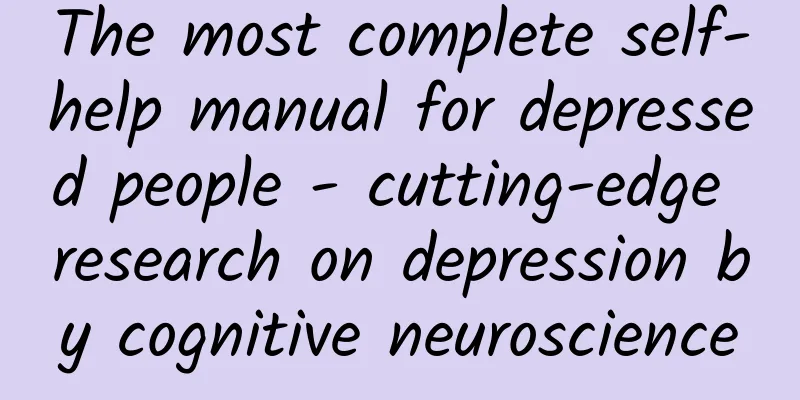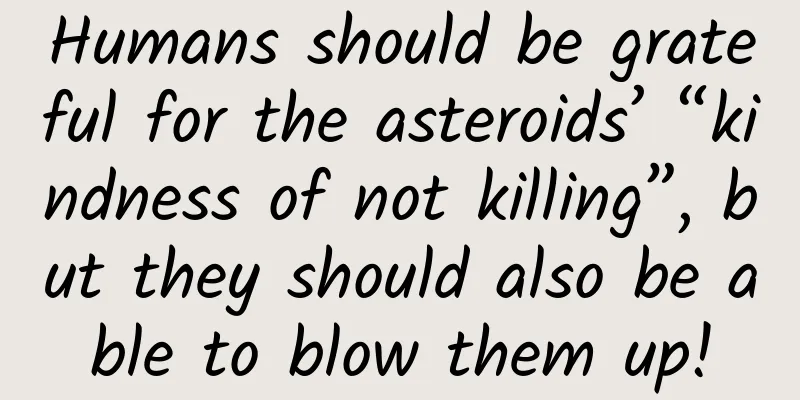The most complete self-help manual for depressed people - cutting-edge research on depression by cognitive neuroscience

|
Neurobiology of social cognition and unipolar depression ——I can suppress all the unhappiness that the world imposes on me, but I cannot suppress the sadness in my heart. ——Dedicated to all those who are depressed Written in front: For decades, scientists have never given up on studying depression. In the past two decades, through the further development of functional imaging in the field of cognition, scientists are identifying the neural mechanisms of the psychological processing of depression. Current research shows that the root cause of unipolar depression susceptibility is not a single area of the brain or a single processing component. More precisely, when emotionally meaningful stimuli appear in the environment, the associated brain systems involved in identifying, processing and responding need to avoid ineffective psychological functions. In other words, "redundant" psychological processing in processing emotional meaning may lead to susceptibility to depression. The specific process of these neural systems processing information with emotional valence has begun to become increasingly clear. At present, it is more likely that the mental behavioral ability requires fully integrated social and behavioral functions, and the failure of one or more subcomponents involved in processing external stimuli will lead to the occurrence of unipolar depression. Moreover, social cognitive deficits are likely to vary with the nature of depression. Therefore, we cannot simply assume that the social cognitive impairments of first-episode depression, recurrent depression, adolescent depression and elderly depression, low depression risk and high depression risk are the same. There is still a lack of understanding of the individual differences in social cognition and the development of major psychological processes in patients with depression. No abnormalities in social cognitive processes have been found to predict the onset of depression. Unipolar depression is not only one of the most harmful diseases among many mental disorders, but its treatment cost and efficacy are enough to illustrate the harmfulness of the disease. The point we focus on is that patients with unipolar depression not only have disordered emotion regulation, but also have changes in neuropsychology and even social cognition. The relationship between social cognitive neuroscience and depression can be seen as the commonality of emotional and social brain areas in neurobiology, and the relationship between social cognitive disorders (executive function, decision-making and emotional abnormalities) and the persistence of unipolar depression. introduction: Depressive syndromes consist of a range of severe psychiatric disturbances, are prone to relapse, and are associated with a considerable risk of subsequent psychosocial impairment, which in some cases may persist for a lifetime. Despite the significant differences in the nature of the different types of depression studied, the DSM-IV has proven to be very successful. Much of the research now focuses on the ability of the number of depressive symptoms to predict the next onset of depressive symptoms, the importance of the association between different types of depressive symptoms, and how these symptoms develop into depressive disorders. An important feature of depressive symptoms is that the mood changes from pleasant to unpleasant or even painful. This mood change is relatively common, can last for a period of time at different times or places, and seriously affects the patient's daily life. This negative mood is accompanied by a series of other symptoms, including negative and chaotic self-cognition, concentration disorder and attention disorder, as well as a series of adverse effects on the physical level, including diet, sleep, spirit and activity. Major unipolar depression Over the past 40 years, most research on affective disorders has focused on major unipolar depression. Depression can be chronic or short-term, and can vary over any period of time. It can range in severity from mild, with only minor deviations from normal functioning, to severe, with patients unable to care for themselves and requiring 24-hour intensive psychiatric care. In community and clinical studies, 50% to 80% of patients with unipolar depression have nondepressive comorbidities involving antisocial behavior, obsessive-compulsive disorder, generalized anxiety, or substance abuse. The precise relationship between the timing of depressive and nondepressive symptoms remains an important component of developmental research. It is now generally accepted that unipolar (and other) depressions are heterogeneous in etiology and clinical presentation, and that genetic and environmental (physiological, psychological, and social) variations combine in ways that increase the likelihood of developing these complex, common mental disorders. Unipolar depression and its development Depression can occur throughout the lifespan, but its nature, features, and consequences may change with age. Depressed children and older adults are less responsive to tricyclic antidepressants, but older adults are more responsive to interpersonal therapy. There are also differences in neurobiological mechanisms; children with depression do not have the generalized “cortisolism” seen in adolescents and adults. Neurobiological systems involved in the pathophysiology of unipolar depression, as well as many of the neuronal circuits thought to be involved in specific behaviors, are not fully developed until adulthood. There is growing evidence that, in prepubertal children, environmental abuse, social factors, and nutritional deficiencies may have a significant impact on the brain circuits that regulate emotion. Of particular importance in this population is the deleterious effects of persistent or intermittently elevated cortisol levels in the amygdala and hippocampus, which render glucocorticoid receptors more susceptible to other toxins and lead to atrophy and failure of function. Therefore, some children may develop a more fragile brain system that is the basis of the emotional-cognitive processes associated with depression. This fragile brain system may not be able to adapt when stress occurs repeatedly, and cannot recover in time after negative events in life. The continued occurrence of dysfunction at the neural level is more likely to accumulate adverse effects on emotional and cognitive processing. The increase in morning cortisol levels in adolescent patients with depression has been found to be associated with the onset of unipolar depression. Excessive secretion of cortisol before and after puberty may increase the risk of cognitive dysfunction in the future. Experiments have also shown that high cortisol levels are associated with cognitive dysfunction. In the last two articles, I explained in detail the relationship between cortisol levels and cognitive function. In addition to the effects of glucocorticoids, the genetic profile of the serotonin transporter changes with age and disease course. Increased neuronal vulnerability enhances activation of the hypothalamic-pituitary-gonadal axis, leading to a significant increase in circulating sex hormones in the peripheral nervous system and brain, and high or low levels of dehydroepiandrosterone (DHEA) in the brain alter the sensitivity of the brain circuit's neural and vascular responses to certain events, such as infection, social adversity, and physical illness. There is evidence that there are differences and commonalities in the development of the disease in patients of different age groups. The emotional-cognitive process is believed to be related to the onset and outcome of emotional disorders. Cognitive theories of depression One of the most common features of unipolar depression is a strongly negative view of one's own and others' experiences. Depressed people are vulnerable because of their negative cognitive schemas. Cognitive schemas are defined as underlying cognitive structures that screen, encode, and evaluate stimuli, ultimately allowing individuals to categorize and interpret experiences in a meaningful way. An individual's cognitive schemas are formed during childhood and are relatively stable throughout life. However, negative cognitive patterns are latent and will only be activated when individuals are exposed to negative situations. Once activated, negative cognitive patterns will bias information processing, thereby abandoning positive stimuli and selecting and encoding negative stimuli, and even distorting the balance of processed information or changing the perception of a certain situation in order to match the biased emotional tone, resulting in "triple negative cognition". "Triple negative cognition" refers to negative thinking about three very important aspects of life: self (thinking that the self is imperfect or useless), the world (making the most negative possible interpretation) and the future (believing that current difficulties and pain will continue indefinitely). In addition, there are more special distortions or logical errors, including overgeneralization (generalizing the whole from a point to produce information distortion), arbitrary inference (jumping to unsupported negative conclusions without any basis), and magnifying or minimizing special events (magnifying negative events and minimizing positive events, resulting in serious evaluation errors). The result is a vicious cycle in which an increase in negative thoughts leads to even lower mood, which in turn increases the activation of negative cognitive patterns, leading to an increase in negative thoughts. Researchers believe that this cycle is important for the pathology and duration of unipolar depression. It involves psychological, biological, and social factors. The second influential theory, the "learned helplessness theory," reflects susceptibility to depression. In this theory, depression is seen as the result of anticipating a state of future helplessness, that is, anticipating bad things to happen and believing that nothing can prevent them from happening. This theory is based on the finding that when dogs were exposed to electric shocks that were inescapable and out of their control, they showed three impairments: motivational impairment (inability to initiate subsequent escape responses when stress was present), cognitive impairment (late learning that current responses can control future stress, due to a learned set of cognitions that "my" responses are not related to future outcomes), and affective impairment (inevitable trauma has a transient affective effect). None of these three impairments appeared in dogs that were given continuous electric shocks but had control over the shock conditions. Researchers believed that helplessness was caused by the uncontrollability of expectations, but later proposed an important determinant - the individual's explanation of the cause of the event. The three attribution dimensions that control helplessness will manifest in the future: internal-external; stable-unstable; global-specific. The three attribution dimensions show the helpless individual's explanation of the cause of the event: whether the cause is attributed to oneself or to other people or the environment, whether the cause is permanent or short-lived, and whether the impact of the cause is global and widespread or only causes failure in certain special circumstances. Therefore, emotional, motivational and cognitive disorders in unipolar depression may be caused by a series of attributions to negative events, that is, the attribution of negative events is of the internal-stable-global type, while the attribution of positive events is of the external-unstable-specific type. Other theories, in clinical applications, suggest that when social adversity causes irritability in susceptible individuals, there is an interdependent relationship between the activation of negative thinking and depressed mood. This interdependence causes individuals to experience a repetitive and reinforcing cycle: increased depressed mood leads to negative thoughts, which in turn leads to increased negativity bias in interpreting current events and predicaments. This negative affective-cognitive cycle is believed to lead to the emergence of clinical depression. There are differences in the negative thinking patterns of individuals in mild depression or dysphoria. Compared with non-susceptible individuals, susceptible individuals may use different types of negative cognition, that is, negative self-cognition and dysphoria interact, thereby reinforcing and maintaining depression. This can explain why not all individuals enter a vicious cycle after experiencing mild depression. Compared with individual factors (psychological and biological factors), my opinion tends to be more about the importance of social factors, because based on the complexity of the environment, no matter how complex the brain is, it is not as complex as the environment it faces. A good environment can not only prevent the continuous negative stimulation from causing mood disorders to the depressed, but also environmental support can help them get out of learned helplessness. We cannot make the assumption that the environment cannot be changed. As part of the environment, individuals can play a positive role. The diversity of unipolar depression Disease heterogeneity It is unclear how genetic, physiological, psychological, and social factors combine to produce depressive symptoms. Furthermore, it is unclear whether specific cognitive and behavioral features that are repeatedly observed are causes or consequences of the disease, and whether these patterns remain stable in recurrent unipolar depression. Individual differences in subtypes of affective disorders may manifest different behavioral patterns, the most obvious difference being between unipolar and bipolar depression. The differences between the two are not only reflected in clinical manifestations and symptoms, but also in neuropsychological functioning and information processing biases. The second clear difference is between the first episode and relapse of unipolar depression. The first episode of depression requires quite high stress, while the stress that leads to relapse is less, and relapse may occur even without stress in the end. Studies have shown that there is a negative correlation between negative life events and the number of episodes of depression. There may be two pathways leading to this detonation effect, that is, the onset of depression is the result of the increasing internal sensitivity of brain processing without external superposition: one through multiple social adversities and the other through genetic influences. Multiple social adversities lead to the first outbreak of depression, and then the internal sensitivity of brain processing is continuously enhanced, and finally relapse of depression will occur in the absence of stress. The association between information processing patterns and dysphoric symptoms in first-episode and recurrent depression may be stronger in people with recurrent depression. The last question is about comorbidities. We know that unipolar depression is often accompanied by other diseases, including anxiety disorders, obsessive-compulsive disorders, behavioral disorders, and substance abuse. Reports have shown that young people are more likely to have comorbidities than the elderly, and patients with one or two comorbidities have worse short-term treatment outcomes and are likely to have more severe depression. Social cognition, unipolar depression, and the brain Social cognition enables humans and other primates to have flexible and diverse social behaviors. However, patients with unipolar depression show a series of functional disorders under the broad category of social cognition. Due to the recent development of neuroimaging and cognitive neuroscience, researchers now believe that patients with unipolar depression not only have emotional regulation disorders, but also have changes in neuropsychological functions, including lack of motivation and interest, inability to concentrate, and making non-optimal decisions. These disorders will eventually affect the patient's interpersonal relationships and even a series of behaviors in the social environment, such as career. The emotional, social brain The 10 brain regions related to the key processing processes in the field of social cognition are: the anterior cingulate gyrus, responsible for autonomous response and reward processing mechanism; the rostral cingulate gyrus, responsible for processing emotional stimuli; the dorsal cingulate gyrus, responsible for error monitoring response selection; the fusiform gyrus, involved in face perception; the superior temporal sulcus, responsible for processing gaze direction and body movement information; the amygdala is responsible for emotion processing; the orbitofrontal cortex, involved in decision-making in emotional situations; the ventrolateral frontal cortex, responds to all possible reward stimuli; the dorsolateral frontal cortex, responsible for executive function and working memory; the dorsomedial frontal cortex, responsible for internal reference and internal and external focus. Positron emission tomography studies have found changes in regional blood flow and glucose metabolism in the brains of adults with unipolar depression, and these changes are manifested in the following brain regions: amygdala, anterior cingulate gyrus, orbitofrontal cortex, and dorsolateral frontal cortex. The report specifically pointed out that the brain regions involved in higher cognitive functions, such as dorsolateral frontal cortex, were reduced, while the brain regions related to regulating emotions and stress responses were increased. In particular, the increase in amygdala activity is thought to reflect the activation of the cerebral cortex in declarative memory, which can explain the rumination of negative emotional memories in individuals with depression. There is evidence that increased activation of the rostral anterior cingulate gyrus may be crucial for recovery from depression. Abnormalities in brain regions with increased local cerebral blood flow during pathological emotional states may vary with the individual's current mood-state, that is, they may increase or decrease depending on the emotional and cognitive manifestations of the disorder. On the other hand, abnormalities found in the orbitofrontal cortex and medial prefrontal cortex may persist even when symptoms are relieved. In autopsy studies of depressed patients, patients have reduced cortical thickness, neuronal size, and neuronal and glial cell density, which leads us to infer the possibility that these pathological neural changes lead to damage to the orbitofrontal cortex function, thus pushing individuals to the brink of depression. Mood-state-dependent and anatomical abnormalities were not only found in individuals in a depressed state, but also in individuals who were induced to feel sad in the laboratory. Compared with patients in recovery from depression, normal individuals who experienced brief sadness also showed changes in the same brain regions, but in the opposite direction. The researchers therefore believe that sadness may be associated with specific patterns of changes in limbic and cortical regions, which have been altered in depressed patients, and that one way to normalize the activation patterns of these brain regions is to eliminate the negative mood symptoms of depression. Given that unipolar depression seems to be associated with dysfunction in both higher cognitive and limbic regions, researchers have reached a consensus on explaining depression, namely that depression is based on the dysregulation of the entire network of brain regions involved in emotional behavior and social cognition. Dysfunction of brain regions that regulate or inhibit emotional behavior can directly or indirectly lead to the emotional, motivational, cognitive and behavioral manifestations of mood disorders. We can hypothesize that interconnected neural structures in the human brain control the core of emotional experience—the completion of sensory, cognitive, and autonomic processing. These neural structures are now thought to be involved in two key pathways: the limbic-thalamo-cortical (LTC) pathway, which passes through the amygdala, medial thalamus, orbitofrontal cortex, and medial prefrontal cortex; and the limbic-cortical-striatal-pallidular-thalamic (LCSPT) pathway. The existence of these pathways supports a neural model of unipolar depression, in which dysfunction of brain regions that regulate or inhibit emotional behavior directly or indirectly contributes to the emotional, motivational, cognitive, and behavioral manifestations of mood disorders. Cognitive and social development in unipolar depression Recent developments in neuroscience have made it possible to describe the neural mechanisms of mood disorders, which has led to a deeper understanding of the cognitive and social manifestations of unipolar depression. It is now widely recognized that patients with unipolar depression show a large number of impairments in cognition, movement, perception, and communication. Depressed patients have impairments in many cognitive areas, and impairments in executive function (social performance) may be particularly prominent among the many impairments. Executive Function Executive functions are inherent to all purposeful behaviors and include interest arousal, purposeful behavior, and reward acquisition. These abilities are necessary for social interaction and enable a person to function well in different environments. Executive functions are distinct from perception, memory, and language cognition, but overlap with attention, reasoning, and problem solving. Task execution includes the following activities: first, forming awareness about the expected goal or activity results, and then achieving this goal through a strategic action plan, while inhibiting or delaying inappropriate behavioral responses in order to make the best behavioral solution. Each of these operations can be called environment-specific action selection. The flexible behavioral selection of the prefrontal cortex plays an important role in social and challenging functional actions. Depressed patients have long-term and large-scale calls to the orbitofrontal cortex and the anterior ventral frontal cortex to inhibit the emotional response of the amygdala, or the amygdala has long stimulated the ventromedial frontal cortex, resulting in reduced activation of the dorsal frontal cortex and the reward system (the function of the dorsal frontal cortex is external reference). This flexibility in behavioral choice depends on the integration of information across a range of abilities, including attention, planning, decision-making, inhibition, and memory. Executive function depends on the performance of these abilities. The role of executive function in unipolar depression A wide range of neuropsychological impairments associated with a global and diffuse range of brain function impairments focus on: attention, behavioral inhibition, memory, decision-making, and planning. However, it is not clear whether these are psychological impairments caused by unipolar depression or the result of an organic disorder. Some aspects of executive functioning are more extensively affected in patients, such as lack of motivation, reduced cognitive capacity and processing resources, attention focused on mood-consistent thoughts, indifference to beliefs and executive efforts to achieve cognitive coordination, and abnormal responses to feedback on behavioral performance. Decision-making processes in unipolar depression The ability of individuals to integrate information during the decision-making process plays an important role in decision-making, and the continuous decision-making ability includes the anticipation of future results and the continuous evaluation of self and reality. Therefore, the core content of the decision-making process may depend on working memory and attention resources, as well as the stimulus content rich in emotional attributes that can affect the emotions and feelings in the decision. Patients with damaged ventromedial frontal cortex perform normally in many neuropsychological tests, including intelligence, memory, language, attention, etc., but they are unable to integrate their emotional experiences and feelings into complex interpersonal social situations. This obstacle is not that they cannot acquire social knowledge, nor that they cannot embed logic into this knowledge, nor is it a language or memory obstacle. Therefore, a systematic framework for neuroanatomy and cognition of decision-making was born - the somatic marker hypothesis. An important function of the ventromedial frontal cortex is to refer to the internal through the autonomic nervous system. The altered patterns of social behavior and decision-making ability in patients with ventromedial frontal cortex damage are a disorder of biological regulatory response. The important claim of this hypothesis is that many processes involved in decision-making operations, including emotions and experiential feelings, are mainly manifested as changes in the representation of physical state. Each emotion has its own unique autonomic nervous system activity. The perception of these physiological changes constitutes the subjective experience of emotion, and the ventromedial frontal cortex is regarded as the core area of emotional experience. The ventromedial frontal cortex is believed to promote the development of a series of neural networks that process complex stimuli, which include a given situation and some individual's internal state. In other words, the ventromedial frontal cortex processes not only external information stimuli but also internal somatic information stimuli, any of which can cause a conscious feeling, such as the awareness of pain. The internal state of an individual is the body sensation, which is the instantaneous representation of the integration of the brainstem, hypothalamus and cortex - the change of the internal state. Therefore, when an individual experiences a specific complex stimulus again, the system in the ventromedial frontal cortex in the neural network will trigger the most suitable physical state and emotion associated with this stimulus. In other words, if a person forms an emotional memory due to the physical stimulation of a certain disease, when the disease relapses, the ventromedial frontal cortex will automatically activate the emotional and physical response from the last time the disease occurred. It is not difficult for us to understand that a crying person always cries after encountering the same thing, a sad person is always sad because of the same thing, and if a person is anxious because of insomnia, then insomnia will make him anxious all the time. This is consistent with brain imaging research - the ventromedial frontal cortex of patients with depression is always overactivated, and this activation can inhibit the activity of the amygdala. This activation is produced by the ventromedial prefrontal cortex in two ways, the first is through the somatic loop, that is, the activation of brain areas by somatic information, and the second is to bypass the body and directly activate brain areas by stimulation without passing through the body. If a person has been bitten by a snake, the second encounter with a snake will activate the somatic emotional memory of the previous snake bite. The somatic memory of the first snake bite is a conscious feeling, while the emotional memory activated the second time is implicit and subconscious. Therefore, somatic markers (the brain's markers of physical sensations) improve execution by providing a biased or motivational signal that can eliminate those poor options and form better decision combinations more quickly. The lack of somatic markers may lead to a loss of bias in multiple response options and outcomes. Decision-making abnormalities have been found in many neuropsychiatric disorders, including mania, substance abuse, and personality disorders, and recent findings support the presence of decision-making abnormalities in unipolar depression. Increased impulsivity may explain part of the poor decision-making that occurs in unipolar depression, but may also be related to other neuropsychological processes, including reduced sensitivity to reward, with higher hyperbolic discounting; insensitivity to punishment, with rewards being considered without regard to losses, with a greater degree of punishment not exceeding the expected reward; and insensitivity to future consequences, with behavior being guided by current expectations. These impaired decision-making abilities may result from factors such as the inability to efficiently choose between two conflicting response options, the inability to weigh different action strategies, and a degree of cognitive impulsivity. The neural basis of decision making The study found that the ventromedial prefrontal cortex and orbitofrontal cortex play an important role in decision making. This suggests that decision making is regulated by a large system that includes cortical and subcortical structures, including the amygdala, somatosensory cortex, insula, and peripheral nervous system. These brain regions also include a range of psychological processes, including impulse control, risk-taking, evaluation, and emotional processing, which are important components of the decision-making process. In particular, the orbitofrontal cortex guides the encoding of information for goal-directed behavior. It guides the encoding of information that converts goals into behaviors. When people can only rely on limited information to make decisions, the role of the orbitofrontal cortex is particularly important. It can help individuals identify the best choice through a large number of connections in the limbic system and induce reinforced motivation, that is, dopamine-induced motivation salience. Another important connection that processes decision-making bias is the amygdala and the inferior prefrontal cortex. Full experience in emotions is to ensure the setting of the body state. If the depressed patient cannot experience the situation well, but directly activates the memory of the last emotional experience, then the body state setting will be hindered, thereby inhibiting the patient from making intentional decisions and considering future consequences. From the perspective of the emotional basis of depression, the amygdala may be very important. Therefore, if people with depression cannot experience situations well, they will also have obstacles in their emotional response to sensory stimuli, changes in self-behavior and personality, social disorders and decision-making disorders, including the inability to initiate, organize and execute normal behaviors, reduced autonomy, indecision, which can lead to broken interpersonal relationships, financial difficulties and more behavioral fixations, such as bedridden and sad alone. Behavioral inhibition and bias in unipolar depression Inhibitory control is another core cognitive process that belongs to the executive function of the cognitive system. It affects the interrelated factors of reasoning, planning and appropriate behavior control, and therefore plays an important role in social cognition. In addition to using executive control to select, form, execute and maintain the best strategy in a given environment, people can also inhibit inappropriate strategies when goals, task requirements change or errors occur. Impaired inhibition may lead to psychopathological consequences. Patients with frontal cortex damage have inhibition disorders in social situations, but not in abstract situations. Functional damage to the prefrontal cortex often leads to the inability to inhibit inappropriate responses in the current situation. This disinhibition behavior hinders the selection of alternative, more appropriate behavioral plans controlled by long-term goals, making the behavior completely determined by the current emotional evaluation of the environment. As a result, the reaction is based solely on the relevant emotional experience, and the behavior is not constrained by social rules. These behaviors often seem inappropriate. Therefore, patients with social cognitive impairment will react to the current social situation rather than future social situations. In a sense, this emotion-based behavioral disinhibition can be seen as a form of impulsivity: not enough thought, analysis, and reflection before a specific behavior. Adults with bipolar disorder have impaired behavioral response and inhibition during emotional tasks, while this ability remains intact in unipolar depression. However, in contrast to social cognitive processing, when considering emotional processing, patients with unipolar depression have impaired inhibition of negative emotions and show a negative processing bias when processing negative emotional stimuli. This mood-congruent processing bias is one of the most important findings in neuropsychological research on depression. There is evidence that such a processing bias exists in adolescents without a history of depression, which shows that the negative emotion processing bias and mood-congruent processing bias are indeed a cognitive weakness that can cause subsequent affective mental disorders. Neural basis of behavioral inhibition and bias Action inhibition is considered one of the main functions of the prefrontal cortex, and researchers initially believed that the ventromedial frontal cortex was the main inhibitory control brain area. However, recent neuroanatomical, electrophysiological, and neuropsychological studies have consistently found that the ability to inhibit inappropriate, dominant response tendencies is an inherent function of the entire prefrontal cortex, while current research evidence mainly focuses on the ventromedial and orbitofrontal regions. In particular, the role of the orbitofrontal cortex in inhibitory control and emotion control has received a lot of attention. Compared with normal subjects who were induced to feel sad, patients with depression showed differences in the activation of the orbitofrontal cortex and ventromedial prefrontal cortex. Animal experiments have shown that monkeys with damage to the orbitofrontal cortex have difficulty completing behavioral inclination tasks when inhibitory behavior is dominant. In general, patients with damage to the orbitofrontal cortex often have the following characteristics: loss of behavioral inhibition, impulsivity, poor attention, and biased attention processes (mood bias). In fact, many patients who show similar impairments in emotional and social behavior often also have damage to the medial prefrontal cortex. The orbitofrontal cortex, ventromedial frontal cortex, and dorsolateral frontal cortex are considered to be part of a three-way separation, in which these specific areas perform cognitive processing in an independent and complementary manner, ultimately achieving inhibitory control. In fact, we can understand the role of these brain areas functionally. For example, when a nurse gives an injection, people need to inhibit the behavior of pulling out the needle from the stimulus, emotion, cognition, mood, and external attention selection. Therefore, people must not respond to the nurse's injection with the behavior of being deliberately injected. Therefore, when the emotional meaning changes, the individual should change behavior accordingly. Regarding the bias of mood consistency, the study found that emotional stimulation caused a decrease in the posterior neural activation of the ventral cingulate orbitofrontal cortex. The lateral orbitofrontal cortex of patients with depression showed abnormal neural responses to emotional distraction stimuli. The function of the lateral orbitofrontal cortex is to respond to the representation of anger. When an individual is angry or sees an angry person, this area will be activated. The abnormal activation of the lateral orbitofrontal cortex may indicate that patients with depression abnormally process anger in response to their own mood and emotional stimulation. The ventromedial prefrontal cortex and orbitofrontal cortex play a role in behavioral inhibition in emotional situations and are abnormally sensitive to the presence of a depressive state. Social cognition, executive function, and responses to adversity If patients with depression have impairments in social cognition, such as research reports showing that patients with unipolar depression have executive dysfunction, then their ability to regulate mood-consistent experiences (adversity experiences) will also be impaired, which will lead to impairments in behavioral responses (manifested as coping style), further exacerbating the persistence and worsening of the depressive disorder. Given that the main role of executive function is to construct, execute, and maintain ideal coping patterns, we can assume that a person's behavior and its consequences in social situations are at least partly determined by attention, behavioral inhibition, and decision-making processes, which have an impact on social coping style. In other words, a depressed person's social behavior disorder may not only be a direct result of executive function deficits, but may also be an indirect result of other social processing processes (such as decision-making deficits). In the framework of three processing levels: 1. Selective attention and sustained attention + behavioral inhibition = framework stage; 2. Selection + action = execution stage; 3. Result = maintenance stage. This means that if any one or more of these stages are disrupted, the optimal behavioral response may be affected, thereby promoting the development of mental illness. Optimal responses may be hindered during execution by: creating behavioral rigidity (fixation), extreme distraction, difficulty maintaining goal-directed behavior, hindering the selection of optimal or alternative action plans, impairing the transition between attention and response, poor decision-making, and reducing opportunities for adaptive coping. Social response Coping style is a pattern of responses to external circumstances that functions to ameliorate potential, undesirable outcomes, such as anxiety or depression. Conceptually, coping style is associated with achieving a number of goals, including reducing the severity of physical injury or emotional trauma, enhancing recovery expectations, maintaining a positive self-image, and improving the ability to recover from negative events. To achieve these goals, different behaviors may be considered, such as seeking advice, listening to music, or reading a book, depending on the specific situation (i.e., the degree of control the individual perceives over the situation) and individual characteristics (i.e., temperament and problem-solving abilities). Generally speaking, social coping options can be roughly divided into two types: one strategy is immediate comfort (i.e. behavioral or cognitive distraction or escape), which is indeed a short-term solution; the other is to try to change the real representation or psychological representation of the environment (i.e. active strategy), which is a long-term solution. Social coping and unipolar depression The appraisal and coping style of adversity are very important for the onset, persistence and outcome of depression. However, the relationship between coping style and unipolar depression is neither simple nor direct. The individual characteristics of unipolar depressed patients affect the choice of coping strategies and the perceived effectiveness. Therefore, the use of coping strategies includes the following characteristics: social characteristics, such as the tendency to perceive most things in life as bad and stressful events; cognitive characteristics, such as low mood and excessive focus on self, impaired problem solving, the view that one is an inefficient problem decision maker, and the tendency to want to break away from environmental control; executive characteristics, such as difficulty in making decisions. People with depression need to obtain more information before they come to a coping response. They also show a social coping style that focuses on emotions and/or avoids coping. Although these strategies may allow people to quickly get rid of the negative emotions that are aroused, they are not long-term solutions. They will make individuals vulnerable to re-injury when facing similar problems in the future. In contrast, problem-focused, active coping requires individuals to direct their attention outward, have the skills to identify and define problem situations, and find appropriate strategies that can provide long-term solutions by managing and controlling the two factors of actual stressors and emotional reactions caused by experience. These strategies can help reduce psychological problems. |
>>: Will artificial starch advance the progress of human civilization?
Recommend
Mobei Kefan Information Flow Advertising Marketing Introduction and Practical Video Tutorial (Baidu Netdisk)
The video tutorials of Mobei Class from introduct...
A large hatchback with a 3-meter wheelbase and free AI visual driving as standard, can the Xiaopeng P7+ challenge the Xiaomi SU7?
In September 2024, Xpeng Motors delivered 21,352 ...
The latest news on the four-child policy in 2022: What are the specific subsidy policies? Can medical insurance be reimbursed?
Since the full implementation of the three-child ...
What does it mean for smart home hardware manufacturers to connect with Tencent?
On October 30, 2014, Tencent Global Partner Confe...
Wuhan tea sn post bar
Wuhan Tea Tasting Contact Information I strongly ...
These 3 types of toothpaste are included in the "blacklist", do you have any at home?
When you wash your face and brush your teeth in t...
How should short video advertisements such as Douyin and Kuaishou be placed?
1. Take a holistic view and use data to understan...
iOS 11.3 can fix the frequency reduction problem, but these models do not have
At the end of last year, Apple admitted that it h...
How to make the layout of the official account look more elegant?
How to make the layout of articles in public acco...
New regulations on supplementary social security payments for rural veterans in 2022: Can they be supplemented? How to make up for it?
Being a soldier is a glorious profession and they...
10 rules for short video promotion!
As we all know, mobile has entered the post-traff...
Countly 15.3 beta released, mobile app statistics analysis
Countly 15.3 beta is released. This version has t...
How to gain customers through Douyin promotion for online education!
In addition to the huge traffic, the performance ...









